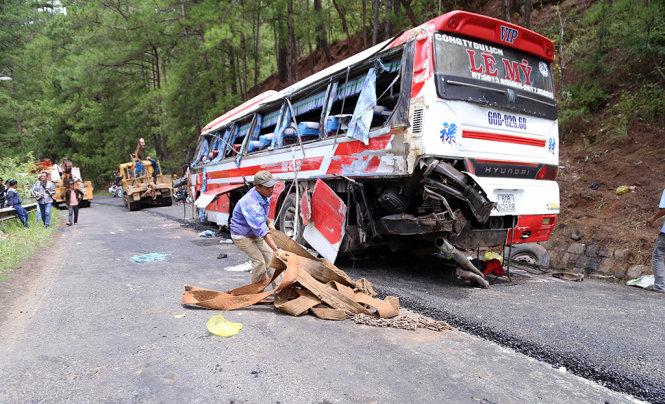It’s border visa-run time again; time to board the scary bus with the scary driver, write a letter to my mum, and try to look at anything except the road.
Each time I travel from Hoi An to Da Nang via the coastal highway it’s clear that the road has become a Formula 1 race track with buses and taxis vying to be the first to anywhere. When I first arrived in Vietnam in 2006, I remember the media controversy over calls for speed limiting devices on large vehicles and tougher penalties for traffic violations. It seems not much has changed.
After another horrific bus accident near Da Lat on June 19, I’m fed up and quite angry. When is the bus madness going to stop? When are the company owners going to be punished for giving their drivers schedules that push them to meet deadly timetables? When are the drivers going to be brought to account for overloading their vehicles, dangerous driving, and reckless risk taking on the roads?
What’s the cause of the carnage? Arrogance from drivers? Greedy owners running too many services? Probably both, alongside a combination of poor driving skills, lack of sleep, speed, alcohol, and stimulants. Bus companies, not rail services, are the backbone of this nation’s transportation system; yet the value of human life doesn’t seem to play a role in that system.
Smaller ‘people carriers’ can be thrown into this mix as well. There are all too many tourists, local and foreigner, with horror stories from road travel in Vietnam. This is an obstacle to developing a safe, reliable, and efficient trans-national transportation system.
As the summer rolls on and tourism increases with the coming cooler months and upcoming national events, the number of bus passengers is only going to increase, creating the potential for even more road fatalities.
The quality of roads also adds terrifying hazards to this deadly mix, but at least it seems the government is taking any steps to fix road widths and other issues. Maybe not as quickly as we’d like, but it is happening.
Like a lot of Vietnamese problems, a major part of the issue is that it is deemed ‘reactionary’ by law enforcement and transportation companies who, instead of rectifying what is wrong, dump the responsibilities and penalties solely on the drivers. Shouldn’t there be more pressure on the owner/operators so that they can be pro-active in saving lives and preventing accidents?
It might be cost-effective to set up a traffic hotline for the anonymous reporting of bus and truck traffic behavior and impose a strict requirement that ALL large vehicles have their company name on their sides and rear. The idea of the hotline would not only be to report violations but also to identify companies whose drivers are constantly creating traffic trouble. It would be a fast track to getting to the heart of the matter: the companies who force drivers to meet unrealistic schedules and shift people and goods as quickly as possible without considering the consequences.
I’m aware that much of this is already in operation in some parts of the country, and that’s one good step in the right direction. Many companies make enormous profits while paying their drivers a pittance, a commission, or a percentage – however the penalties for when problems occur don’t seem to fit the crimes. Up the ante and make the companies pay not only the fines but the additional costs for damage to the environment and communities who lose their loved ones.
Australia, my birth country, has experienced an ongoing battle for decades over the terrifyingly regular event of truck accidents brought about by driver fatigue and the over-use of stimulants that keep drivers awake, as well as the speeding caused by tight transport schedules.
In Vietnam, rural speeds tend to be higher and driver fatigue issues dull reaction times, so accidents can quickly become more severe. Curiously, while Australia made laws limiting the legal time commercial drivers could drive before taking a compulsory break, it made little impact until many companies were examined in detail and penalized. Since Vietnamese drivers are prey to many forms of pressure, have a weak union presence, and lack the ability to organize effectively against employer pressure, the national government has to take on the burden pressuring companies to accept slower and better driver habits.
One last point – much of Vietnam’s billion dollar tourist trade is moved by plane and bus. With each new tourist destination that opens, particularly in the mountains and other attractions such as Phu Quoc, bus services are expanding extremely quickly, yet the level of traffic control hasn’t changed much in the last ten years. Why put the tourism dollars and human lives at risk if it’s going to cost the nation so much in heartache, resources, money and reputation?






















































